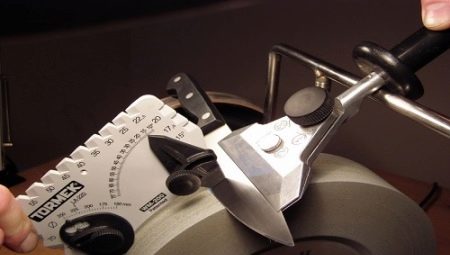Dull knives - every cook’s nightmare. Cooking with such a knife turns into torture, so the fact that they can be imprisoned at home is a lot of luck. But there are some subtleties that you need to know to make the knife sharper, and not dull it even more. First of all, it is necessary to find out what exactly is the angle of sharpening and why it is needed at all.

What is it and why is it important?
First of all, it is worth remembering that a universal grinding angle, equally suitable for all types of knives, simply does not exist. The choice of the right one will depend only on what the knife is used for. Now you can figure out what it is. The term "sharpening angle" has many characteristics. On the knife, the sharpening angle is the one on which the carts converge. And the supply, in turn, is the very place where the slopes of the blade smoothly pass into the cutting edge.
To correctly determine the angle, approaches and descents of the blade, you need to at least roughly imagine the design of the knife. It happens that the knife has no leads, and then the angle of sharpening is equal to the angle of convergence of the slopes, but such are extremely rare. Sometimes the angle of sharpening is the angle between the surface of the grinding material and the sharp edge of the blade.


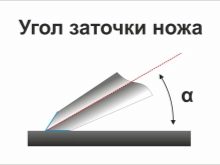
First we find out what sharpening is. This is the restoration of the initial parameters of the cutting part of the edge. Of course, it can be changed, but then you need to look at the material from which the knife is made. Some are made from fragile materials and may not stand up to rough work. Here are the most commonly used materials from which knives are made.
- Carbon steel It is a special alloy of carbon with iron, with the addition of manganese or vanadium. Such knives sharpen perfectly, but they rust over time.
- Stainless steel often found in kitchens. It is also an alloy of carbon, iron and chromium with the addition of nickel or molybdenum. Very often, such knives are blunt, and therefore sharpening is required much more often. If suddenly the steel of the blade became dull, this means that the knife is no longer suitable for further use.
- Stainless high carbon steel - an alloy of stainless and carbon steel, in which cobalt, molybdenum and vanadium are added. It retains all the best properties of these two alloys, that is, it has high strength, sharpness and time without sharpening.
- Damascus steel considered one of the best (and expensive) materials. It is forging, which involves the alternation of soft and hard alloys. Damask steel products are always sharpened by hand.
- Titanium alloy made by sintering titanium with carbide inserts. Sharpening is rarely required for such products. The alloy requires careful handling, as well as the presence of special skills and professional equipment for sharpening.
- Zirconium alloy (ceramic) - This is ceramics after pressing and firing. Such products retain their sharpness for a very long time, but require careful handling and storage. Used for slicing soft, thawed foods. If you need to sharpen such a knife, then you need to purchase special equipment.

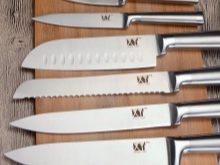
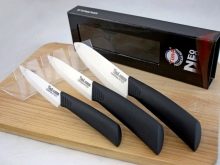
So, before choosing a particular sharpening angle, you need to find out what material the knife is made of. Based on knowledge of the material, certain conclusions can be drawn about the strength of the product and what it is suitable for. For example, if a knife made of stainless high-carbon steel can be used to cut frozen foods, then ceramic will very poorly survive such handling.
A properly selected sharpening angle will help to achieve a balanced pressure distribution across the blade, which will increase the sharpness and cutting quality of the product.
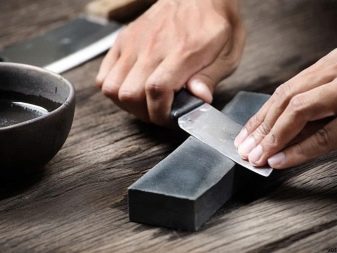

Standard values
There is a certain classification of sharpening angles related to the area in which a particular variety is used. This classification is based on the general position that with a smaller angle of sharpening the blade is much sharper, but lower strength. Accordingly, with a larger sharpening angle, higher strength, but lower sharpness. For kitchen knives, parameters from 10 to 60 degrees are used, but here there is a division by type of use.
- Regular table knifeused during serving should be equal to 55-60 degrees.
- Household, kitchenused in home cooking is approximately 30-35 degrees.
- Professional kitchen, which is used at various power points, sharpen at 25-30 degrees.
- Chef knife can be used for cutting a wide variety of products, it is sharpened at 20-25 degrees.
- Fish knifehas a sharpening angle of strictly 25 degrees.
- Meat cutter grind at an angle of 30 degrees.
- Vegetable knife usually has an angle of 35 degrees.
- Root crop knifehas an angle of 22-25 degrees.
- For boning knife use an angle of 25-30 degrees.
- The knife that separates the loin, should have a sharpening of 10-15 degrees. Such knives should be as sharp as possible in order to more accurately separate the loin portion from the rest of the carcass.
- For frozen meat or fish, which are very hard and can damage knives made of brittle materials, set the sharpening angle to 30-45 degrees, focusing not on sharpness, but on the strength of the blade.
- Small pen (folding, folding) products are sharpened at an angle of 20-25 degrees.
- Tourist and hunting knives usually sharpened for a specific focus.For cutting carcasses, where most of the sharpness is needed, the product is sharpened at an angle of 30-35 degrees, and with priority on strength and durability, an angle of 40-45 degrees is chosen.
- Special boot knives also have two varieties. The first - repair shoe, sharpened by an angle of 30-40 degrees. The cutting shoe is sharper, therefore it is sharpened at an angle of 20-25 degrees.
- Planing universal (it’s universal carpentry) should be sharpened at an angle of 30-45 degrees.


This classification implies the most accurate sharpening for a particular type of work performed by a knife. But what if you need to sharpen a knife and choose the right corner of the house, where you can do without a detailed table?
How to choose the best angle?
Home use involves a less strict division of knives for their intended purpose. It is unlikely that someone will distinguish a knife for vegetables from a knife for root crops. Then it’s enough to calculate the universal angle of sharpening, which is suitable for most kitchen work. The most suitable angle for a kitchen knife, which will become universal for cutting various products - 30-35 degrees. In this embodiment, emphasis is placed on sharpness. When wear resistance is a priority, it is better to sharpen the product at an angle of 40 degrees.
The correct angle value can be determined taking into account the table of generally accepted values. This will help to navigate with which particular characteristic is more important at the moment: sharpness or strength.
Pay attention to the material: depending on this, you can return the original sharpness, or you can completely dull the product. The harder the material, the smaller the sharpening angle.
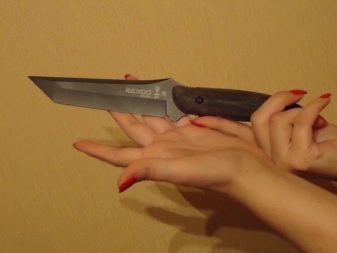
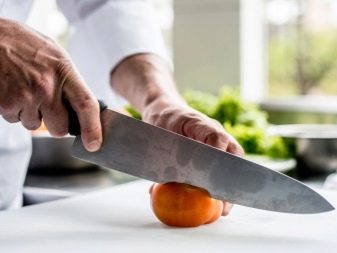
Corner Tools
You can most accurately set the angle using a goniometer. However, this is not the most common household item. therefore you can get by with a protractor with scissors. This method does not give absolute accuracy, but will allow you to calculate the approximate value. You will need scissors and a protractor. Open the scissors and insert the center point of the knife. Then flatten the ends of the scissors until they touch the blade. Remove the knife and carefully, so as not to lose the measured result, lean the scissors on a paper sheet and circle with a pencil. Then measure with a protractor.
Sharpeners are divided into mechanical and electrical. On electric sharpeners, the sharpening angle is already set. In mechanical sharpeners, calculating the angle of inclination is also difficult. The effect of sharpeners is short-lived, but their advantage is that sharpening is much faster, and this is convenient when you urgently need to cook something.
However, an electric sharpener with adjustable grinding angle can greatly simplify your life. It is very simple and intuitive to use.
Different models may have different equipment, but there will always be a sharpening angle adjuster. The only disadvantage of this machine may be that it takes up a lot of space.
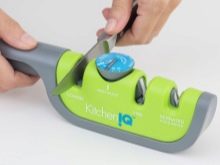
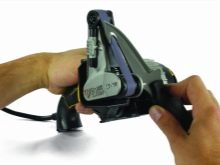

How to sharpen a knife?
There are a lot of devices for sharpening a knife. Each has its own specifics of work and its own difficulties.
- Whetstone. The most common for sharpening a house. Very easy to use, the only difficulty is maintaining the angle of sharpening. It is necessary to have two bars: coarse and fine-grained. First, the blade is leaned against a coarse-grained block at an angle of 20-25 degrees and advanced along the surface of the bar. Try not to change the angle. After turn over and sharpen the other side. Continue sharpening both sides alternately. After changing the bar to fine-grained and sand the product.
- Musat. It is used only for a slight correction of sharpness. If the knife is dull completely, then just a nutmeg will not be enough. We take a knife in one hand and musat in the other. We approximately calculate the angle of 25 degrees, and about 4-6 times we drive the blade along the musat in both directions.You can emphasize musat on the table, if you suddenly hold the instrument with your hands it will not be very convenient.
- Pocket sharpeners are small whetstones that are already placed in a plastic case. They already have the necessary angle, so you do not have to stand and stand it.
- Grinding machine. Represents two abrasive wheels rotating due to the presence of an electric motor. It is not recommended for beginners to use, since when using such a tool it is easy to damage the blade. Suitable for masters who know how to properly set the angle and avoid heating the metal.

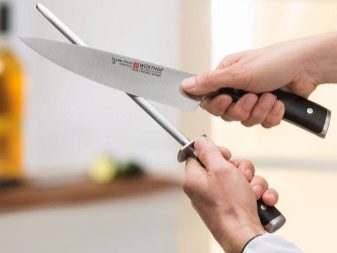
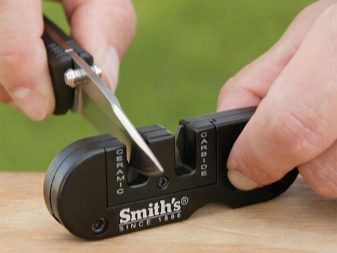
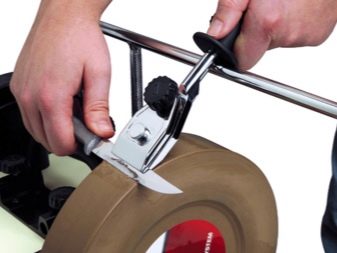
There are also extreme sharpening methods that will work when nothing else is at hand. This may include:
- ordinary cobblestone, which can slightly improve the condition of the blade;
- one more knife, when the knives are rubbed with blades against each other for 5-10 minutes, while both are sharpened;
- a large fragment of a bottle or other glass product (it is important not to hurt yourself when sharpening);
- a leather belt is also often used to grind a blade.
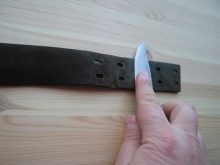
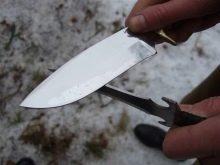
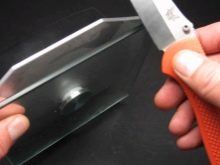
Of course, these methods are not the best and most effective, but if there is nothing else at hand, for some time they will help to sharpen the knife. If you choose the right angle of sharpening, then it will become much easier to work with the knife, and its sharpness and wear resistance will increase significantly.
See how to set the knife sharpening angle in the next video.
